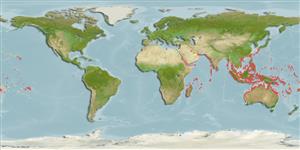>
Ovalentaria/misc (Various families in series Ovalentaria) >
Pomacentridae (Damselfishes) > Glyphisodontinae
Etymology: Abudefduf: Arabic, abu = father; this fish is the leader of the reef against other species (Ref. 45335).
More on author: Lacepède.
Environment: milieu / Zona climática / intervalo de profundidade / distribution range
Ecologia
marinhas associadas(os) a recifes; não migratória; intervalo de profundidade 1 - 20 m (Ref. 58652). Tropical; 33°N - 35°S, 32°E - 143°W (Ref. 56027)
Indo-Pacific: Red Sea to Pinda, Mozambique (Ref. 4391) and the Tuamoto Islands, north to southern Japan, south to Lord Howe and Rapa islands. Not recorded from the Hawaiian Islands.
Tamanho / Peso / Idade
Maturidade: Lm ? range ? - ? cm
Max length : 19.0 cm TL macho/indeterminado; (Ref. 90102)
Descrição suscinta
Chaves de identificação | Morfologia | Morfometria
Espinhos dorsais (total) : 13; Raios dorsais (total) : 12 - 16; Espinhos anais: 2; Raios anais : 12 - 14.
Body shape (shape guide): short and / or deep; Cross section: compressed.
Adults inhabit inshore and offshore coral or rocky reefs. Also in shallow coastal reef flats or crests, usually where lots of tall soft corals or hydroid colonies are present (Ref. 48636). Often found in groups feeding at midwater or tending nests among rocks and coral ledges (Ref. 90102). Feed on zooplankton and algae and aggregates high in the water column (Ref. 9710). Oviparous, distinct pairing during breeding (Ref. 205). Eggs are demersal and adhere to the substrate (Ref. 205). Males guard and aerate the eggs (Ref. 205).
Ciclo de vida ou comportamento de acasalamento
Maturidade | Reprodução | Desova | Ovos | Fecundidade | Larvas
Oviparous, distinct pairing during breeding (Ref. 205). Eggs are demersal and adhere to the substrate (Ref. 205). Males guard and aerate the eggs (Ref. 205), mostly deposited on rocks or dead corals (Ref. 128523). Males may manifest cannibalism occasionally (Ref. 128523).
Allen, G.R., 1991. Damselfishes of the world. Mergus Publishers, Melle, Germany. 271 p. (Ref. 7247)
Status na Lista Vermelha da UICN (Ref. 130435: Version 2025-1)
Ameaça para os humanos
Harmless
Uso pelos humanos
Pescarias: pouco comercial; Aquário: Aquários públicos
Ferramentas
Relatórios especiais
Baixar XML
Fontes da internet
Estimates based on models
Preferred temperature (Ref.
123201): 24.7 - 29.3, mean 28.4 °C (based on 3258 cells).
Índice de diversidade filogenética (Ref.
82804): PD
50 = 0.5000 [Uniqueness, from 0.5 = low to 2.0 = high].
Bayesian length-weight: a=0.02188 (0.01267 - 0.03777), b=3.10 (2.95 - 3.25), in cm total length, based on LWR estimates for this species & Genus-body shape (Ref.
93245).
Nível Trófico (Ref.
69278): 2.7 ±0.30 se; based on food items.
Resiliência (Ref.
120179): médio(a), tempo mínimo de duplicação da população 1,4 - 4,4 anos (Preliminary K or Fecundity.).
Fishing Vulnerability (Ref.
59153): Low vulnerability (10 of 100).
🛈
Nutrients (Ref.
124155): Calcium = 77.1 [39.9, 122.3] mg/100g; Iron = 0.654 [0.404, 1.051] mg/100g; Protein = 18.3 [17.1, 19.4] %; Omega3 = 0.0999 [, ] g/100g; Selenium = 24.3 [14.0, 44.7] μg/100g; VitaminA = 72.9 [20.5, 239.9] μg/100g; Zinc = 1.51 [1.05, 2.17] mg/100g (wet weight);
